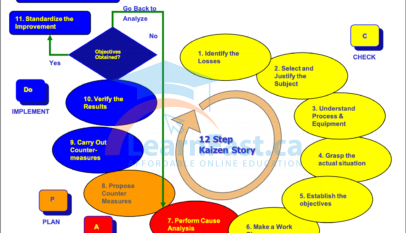In the vast galaxy of business operations, where projects are akin to stars and processes are the constellations that bind them, a subtle and seismic force emerges that ensures our celestial bodies move in harmonious synchrony. This force, deeply embedded in the cosmos of Project and Operations Management, is known as Key Performance Indicators, or KPIs.
For many, KPIs are the heartbeats that hint at the health of a project, the compass needles that direct operations toward their North Star. Yet, for all their prominence, there remains an aura of enigma surrounding them. How do we define the right KPIs? What makes them tick? And, most importantly, how can we harness their potential to illuminate the path towards success?
As we embark on this journey through the universe of KPIs, we’ll unravel their mysteries, diving deep into their significance, their structure, and the strategic insight they provide. But more than that, this exploration is about recognizing that there’s a story behind every metric—a narrative of ambition, effort, and evolution.
So, whether you’re a seasoned project manager looking to refine your performance measures or a newcomer eager to grasp the foundations of operational excellence, this post promises to be your guiding constellation, shedding light on the most vital indicators that shape and steer the world of Project & Operations Management.
Let the voyage begin.
- Project Metrics:
- Completion Rate: On-time project finish rate.
- Budget Adherence: Expense vs. allocated budget comparison.
- Scope Creep Frequency: Monitoring project scope alterations.
- Resource Utilization Rate: Effectiveness of team time usage.
- Stakeholder Satisfaction: Level of key stakeholder contentment.
- Risk Mitigation Efficiency: Effectiveness of risk management.
- Change Requests Processed: Total change requests handled.
- Communication Effectiveness: Clarity & efficiency of discussions.
- Milestone Achievement Rate: On-schedule milestone completion.
- Quality Defects Detected: Number of deliverable quality issues.
- Financial Metrics:
- Rework Rate: Frequency of deliverable revisions.
- Project ROI: Project return on investment.
- Benefits Realization: Achieved vs. intended benefits.
- Cost Variance: Budgeted vs. actual costs difference.
- Schedule Variance: Gap in planned vs. actual timelines.
- Earned Value: Work done value vs. planned value.
- Cost Performance Index (CPI): Budget utilization efficiency.
- Schedule Performance Index (SPI): Project schedule adherence.
- Issue Resolution Time: Time to solve project issues.
- Overhead Cost Percentage: Non-labor cost percentage of the total.
- Team & Collaboration Metrics:
- Team Turnover Rate: Team member exit rate during projects.
- Team Collaboration Index: Efficiency in team collaboration.
- Vendor Performance Index: Vendor reliability and effectiveness.
- Cross-functional Collaboration Rate: Inter-departmental collaboration frequency.
- Team Satisfaction Index: Team morale and contentment level.
- Resource Skill Match Rate: Team skill alignment with project needs.
- Efficiency Metrics:
- Task Completion Rate: Finished vs. planned tasks.
- Overdue Tasks: Tasks exceeding their due date.
- Dependency Bottlenecks: Task delays affecting subsequent tasks.
- Resource Allocation Efficiency: The resource project needs alignment.
- Tool & Tech Utilization Rate: Project tool and technology usage effectiveness.
- Client & Stakeholder Metrics:
- Knowledge Transfer Efficiency: Success in project knowledge handover.
- Project Documentation Completeness: Comprehensiveness of project docs.
- Customer Feedback Score: Customer project satisfaction level.
- Stakeholder Engagement Level: Stakeholder interaction efficiency and frequency.
- Requirement Clarification Requests: Times clarifications were sought.
- Environmental Impact Metrics:
- Energy Consumption: Project’s energy use.
- Carbon Footprint Reduction: Carbon emissions cut in green projects.
- Technology & Process Metrics:
- Iteration Completion Rate: Completion rate for agile iterations.
- Backlog Burn Rate: Speed of addressing agile backlog items.
- Work In Progress (WIP) Limits: Concurrently processed tasks (relevant for Kanban).
- Technology Downtime: Duration of tech/tool outages.
- Post-Project Metrics:
- Post-Project Review Completion: Post-project review conduction rate.
- Project Knowledge Retention: Post-completion knowledge retention level.
- Client Retention Post-Project: Frequency of returning clients.
- Post-Implementation Bug Rate: Bugs reported post-implementation.
In the dynamic and intricate world of project and operations management, our compass has always been the relentless pursuit of excellence. As we’ve traversed through the detailed terrains of Key Performance Indicators (KPIs) in this post, it’s clear that measuring performance is not just about numbers; it’s about capturing the essence of what truly matters.
KPIs are not mere metrics but stories of effort, dedication, progress, and aspiration. From gauging project timelines to ensuring operational efficiency, the KPIs we’ve discussed embody the overarching philosophy that what gets measured gets managed. And in the meticulous operations world, precision is not a luxury but a necessity.
But while we celebrate the exactitudes of data, it’s vital to remember that KPIs serve the people, not the other way around. They are the benchmarks that guide teams towards common goals, the lighthouses that prevent ventures from veering off course, and the pulse checks ensuring that a project’s heart is beating strong and steady.
In essence, the real value of KPIs lies in their ability to bridge the chasm between vision and reality. They provide clarity in chaos, direction amidst distraction, and a sense of purpose when the path becomes blurred. As stewards of projects and operations, we choose these indicators wisely, interpret them judiciously, and act upon them decisively.
As we draw this post to a close, let it be known that in the grand tapestry of project and operations management, KPIs are the threads that hold everything together. They are the silent sentinels that watch over our endeavours, ensuring that every step we take is one towards success.
And so, armed with the insights from this post, may you chart a course where performance is not just about reaching destinations but about appreciating the journey. Where every metric tells a tale, every indicator inspires action, and every project becomes a testament to the power of informed strategic management.

















